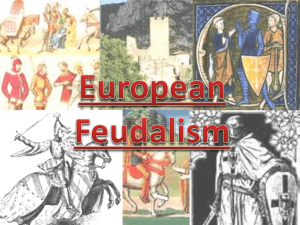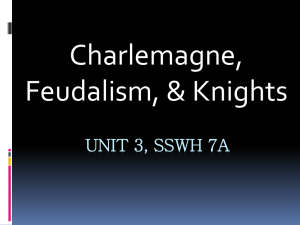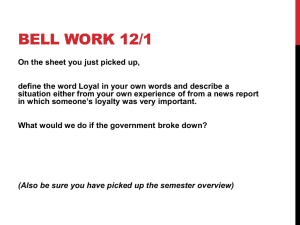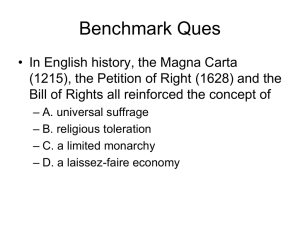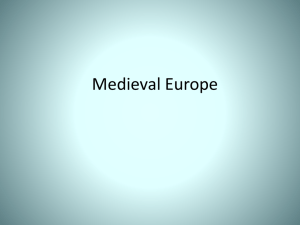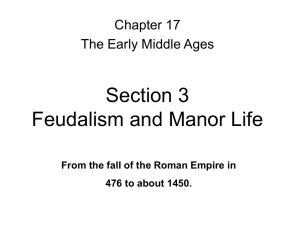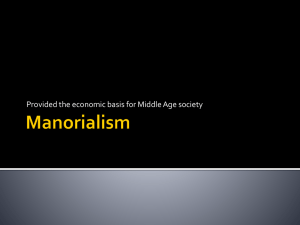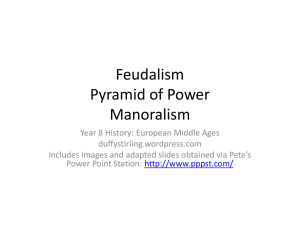3.24 Feudalism and Manor System Walk around - herthel
advertisement
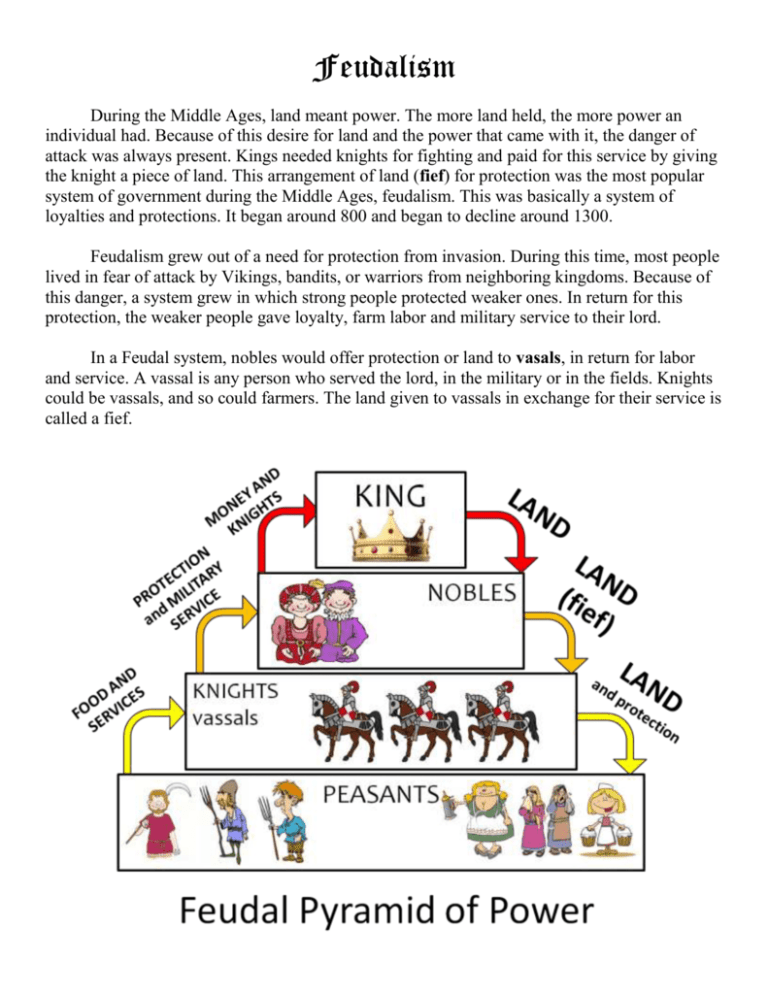
Feudalism During the Middle Ages, land meant power. The more land held, the more power an individual had. Because of this desire for land and the power that came with it, the danger of attack was always present. Kings needed knights for fighting and paid for this service by giving the knight a piece of land. This arrangement of land (fief) for protection was the most popular system of government during the Middle Ages, feudalism. This was basically a system of loyalties and protections. It began around 800 and began to decline around 1300. Feudalism grew out of a need for protection from invasion. During this time, most people lived in fear of attack by Vikings, bandits, or warriors from neighboring kingdoms. Because of this danger, a system grew in which strong people protected weaker ones. In return for this protection, the weaker people gave loyalty, farm labor and military service to their lord. In a Feudal system, nobles would offer protection or land to vasals, in return for labor and service. A vassal is any person who served the lord, in the military or in the fields. Knights could be vassals, and so could farmers. The land given to vassals in exchange for their service is called a fief. Manor System The manor was the name given to the land controlled by a lord and worked by peasants. Many manors were in the kingdom controlled by one king. Manors were self-sufficient, meaning that they didn't have to travel to get most of their needs. Inhabitants of the manor raised crops and livestock for food, spun wool for clothing, tanned leather for shoes, and cut lumber for furniture and buildings. Included in the manor were: the manor house (or castle) that housed the lord Land and homes owned by the knights that had sworn allegiance to the lord Stables and pasture land for the animals owned by the lords or knights Homes for the serfs Farming land used for growing crops A village including a church and homes for the peasants who had sworn allegiance to the lords or knights Village buildings including blacksmith and carpenter shops, the lord's winepress, flour mill, and baking oven Woodlands surrounding the village. The lord directed all activities on the manor. He determined what would be produced and how. Serfs were responsible for providing physical labor. Several innovations led to more efficient production on a manor. First, water wheels for water and wind power were used in the baking mills. Iron (which had to be obtained from outside the manor) was used to make tools like hoes, axes, scythes, and plowshares. Third, horses were used to plow the fields. Farmers also learned that leaving a field empty for a year helped improve the soil, thus improving the size and quality of harvest. This practice is called a three-field system. One field was planted in the spring for a fall harvesting. Another was planted in winter for a spring harvesting, and the third would not be used for a year. Christianity was very strong during the Middle Ages. The hurch held great power over all the people (Christendom). Because of this love and allegiance to their church, kings often made decisions, which were strongly influenced by the church leaders. The Manor System 3 field crop rotation calendar mill Nobility King - The king, being the largest landowner, was the most important person in the feudal system. The government system of fedualism is similar to a pyramid with the king sitting at the top of the pyramid. Everyone else owed loyalty and service to the king. Below the king came nobles. Lords- Each noble gained land from the king in a contract or agreement called a feudal bond. Under this contract, nobles pledged their allegiance to the king in exchange for the grant of land. The nobles with the most land were the lords. The amount of land owned gave lords power over others. Lords lived in a manor. His home was the largest in the area. If the lord lived in an area that had frequent violent attacks, he might build a castle. Castles served as the protection site for all those who had a contract agreement with the lord. They were mostly made out of wood, and not very comfortable. Around the lord's home were the homes of his knights, peasants, and serfs who worked for the lord in exchange for his protection. Lords commanded an army made of knights who owned him military service in exchange for their land. When the lord made a law, he used this army to enforce the law. However, he could not use this army to stop his knights from fighting with each other or to enforce the laws that his knights made for those living on the knight's land. Lords were also the judges. If people had an argument with one another, they would bring the argument to the lord to be settled. Knights- The largest group of nobles were the knights. All noble men were required to become knights. Those who were proven too weak were sent to the monastery to become a scholar or monk. Knights were the armored horsemen and warriors that were so important in the protection of the land holdings. Before becoming a knight, a boy had to go through a lot of training! The son of a noble would being training at age 7. At the age of 21, he would become a knight. At this point, he pledged his loyalties to his lord. He promised to fight for his lord, defend the Christian Church and protect anyone who needed his help. In a special ceremony, the lord tapped the knight on the shoulders with his sword (which the priest had blessed). Knights were expected to follow the Code of Chivalry, or rules of honorable behavior. The Code said that knights would be brave, honorable, prtoect the weak, and honor women. Commoners Commoners are divided into two groups- peasants and serfs. A peasant's life was decided by birth and could not be changed. Peasants were the work force in medieval times. All worked from the necessity to survive as no food or shelter was given. Peasants could not own land since nobles owned all the land. Peasants made agreements with nobles in exchange for protection from invaders. According to the agreements, peasants would farm and tend animals for the nobles. In exchange, the nobles would allow the peasants to live in ahome in the manor and would protect the peasant and his family. Peasant life was hard! Peasants worked in their fields for 3 days, and worked in the noble's field for 3 days each week. Peasants were also expected to do repair work around the manor, on roads and bridges. No one was allowed to work on Sunday. All crops from the nobles field went to the noble. Crops from the peasant's field were divided, with 1/10 going to the church (called the tithe), and another amount going to the noble in payment of taxes. The peasant could have whatever was left. Peasants often starved when there was a poor crop season. Peasants become serfs by becoming in debt to the noble. This could be beacuse of care given to the peasant, or lack of taxes being paid. Serfs are not free men, nor are the slaves to the nobles. They do not belong to nobles, but do belong to the land owned by the noble. They can not be given away, sold, or otherwise removed from the land. A serf family passes generation after generation working on the land. Serfs have no rights. If the land changes hands through war, serfs still remain on the land. Most peasants were serfs. Coat of Arms On the battlefield, it was hard to distinguish friend from foe, since all the knights were covered in armor. Knights chose symbols as their marks of identification. Each knight had his own symbol design marked on his shield, tunic (jacket), and cloth covering his horse. This was known as the coat of arms. The coat of arms design was a symbol of an event, occupation, or outstanding quality in one's life. A herald (editor) was selcted to supervise the selection of colors and symbols so that no two were alike. Now, you will design your own coat of arms. Draw a shield, then choose one large symbol that shows an event or quality of your life. No letters or numbers are allowed, since most people during the Middle Ages don't know how to read. Towns With the end of the Viking raids, and invasions from Muslims and other peoples, peace returned, as did trade. Trade fairs were places where buyers and sellers could meet. They were held in towns and drew huge crowds because merchants were willing to travel long distances to visit them. There was a variety of goods available for sale, including fine luxuries like silk from China. Trade fairs were held once a year at specific locations, but could last for several months. For everyday needs, people would visit their weekly local market. Trade encouraged people to use money in Europe, instead of being paid with goods through the barter system. Money became a more accepted method of exchange, and cities began minting their own coins. Some merchants allowed people to buy on credit, or the promise of a later payment. A customer would receive the goods after signing a document stating when and how they would repay the debt. In 2013, most people in America use credit cards to make purchases, and pay the statement at the end of the month. The increase of money and credit led to the creation of the first banks. Since religious laws prevented Christians from charging interests on loans, most money-lenders were Jews. Jews were barred from many other jobs since they weren't Christian. Thriving trade, an increase in the use of money, and new agricultural technology led to the expansion of towns and cities. Towns and cities were small and crowded. Streets were narrow and winding. Shops and houses, which were all built of wood, could be about 3 to 4 stories high. Tall buildings blocked sunlight, so towns and cities tended to be dark. Streets were crowded with people, animals, and waste. There was no public sanitation, so trash lined the streets. This caused disease. Fire and crime were also threats. Towns smelled terrible, due to human and animal waste and the constant burning of wood and dung for businesses. Rivers and lakes were polluted, so people in towns relied on well water. In town, women would help their men run businesses, and women would take over if their husband died. Life in cities and towns wasn't always bad, however. There were churches, eating halls, and markets where people could socialize. Guilds provided entertainment in the form of plays and festivals for religious holidays. Sports were also common. As cities and towns grew, people learned more about the wider world. Arts and new ideas were spreading. Industries and Guilds Craftsmen organized into guilds, or business assoications designed to protect the interests of a group of people with the same occupation. Guilds regulated industry by restricting competition, setting quality of production, price, wages and hours, and standards of workmanship. The guilds wanted to give a just price, or fair price, to both the consumer and the producer. The guilds strictly regulated the training and advancement of workers. The apprentice, or beginning worker, bound himself, generally without pay for a 7-year period, to a master craftsman. The master supported him and taught him the craft, social manners, and morals. After this period, the apprentice might be promoted to the journeyman class. The journeyman, or intermediate worker, could be employed in any shop in return for a daily wage. If he passed a test by producing a "masterpiece," he advanced to the master class. The master craftsman could open his own shop where he was both a worker and an owner. Guilds combined features of our modern labor unions, employer associations, political parties, and mutual aid societies. Daily Life Noble Life Women in the Middle ages were treated as helpless beings. They were simply posessions of their fathers or their husbands. Even noble women had few rights and little control over ther own lives. When the noble men were at war, women took care of the castle or manor and the lands owned by the noble. They assured that everything ran smoothly. When the men were home, women were busy training the pages (those training to be a knight) in manners and education. Women also spent time planning meals, weaving, doing embroidery, caring for young children, and instructing young girls in how to behave like a lady. When not at war, the men ran the manor, making sure the peasants and serfs paid their taxes and were taken care of and supervised. They also supervised the knightly training of the boys under their care. At least once a week, noble men went hunting in the manor forests, usually for deer. From about age 7, children spent their days in training. Girls were sent to other castles or manors to learn how to run a household, care for children, weave, sew, play instruments, dance, sing, and other skills required to be ready for marriage. Many girls married at about age 12. Boys were learning to become knights. Men rarley married before he age of 30. Babies were usually sent to live with a caregiver until the age of 2. From ages 2 through 7, children were returned home and cared for by their mothers and the caregivers. They played games and had some toys. Noble children had dolls, spinning tops, rattles, blocks, balls, whistles, and puppets. Little boys played with wooden solderis, whips, toy horses, and wooden sowrds. In the evenings, nobles may play chess or checkers. Nobles lived in manor houses or castles. The castles were built for defense, not comfort. They were dark, stuffy, and made of wood. Private rooms were rare, since soldiers and servants also lived in the castle. Peasant's Life Peasants lived in simple 1 or 2 room cottages or huts. They had straw roofs that would catch on fire easily, and the floor was made of packed dirt. There were few small windows, to keep the heat in. There wasn't much furniture, other than wooden stools and benches. They used straw for bedding, which had to be replaced often because of bedbugs and lice. Peasants spent their days working the fields, but worked the hardest in the autumn, during harvest season. During the harvest season, the entire family worked in the field all day. During the non-harvest season, women and girls typically cooked, sewed, cared for animals, and grew vegetables. For most meals, peasants ate bread, vegetables, and cheese. Clean water was hard to find, so most people would drink ale. There were several feast days that peasants would celebrate. These days were Roman Catholic holidays that celebrated great events of faith. On feast days, peasants wouldn't work, got to eat meat (usually pork or bacon), and be with friends and extended family. Nobles and Peasants Create a Venn Diagram to compare and contrast the home, dress, work, and play of nobles and peasants. Nobles Peasants
